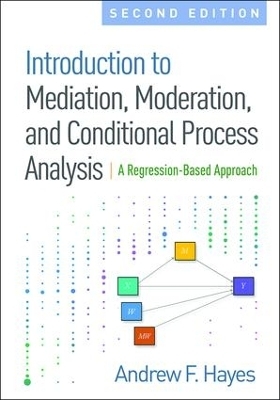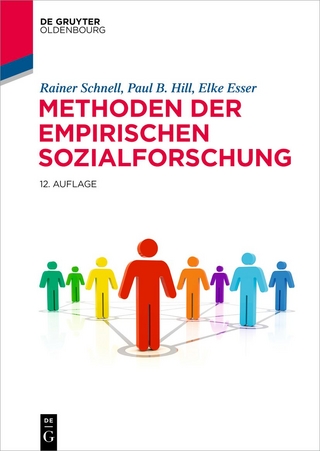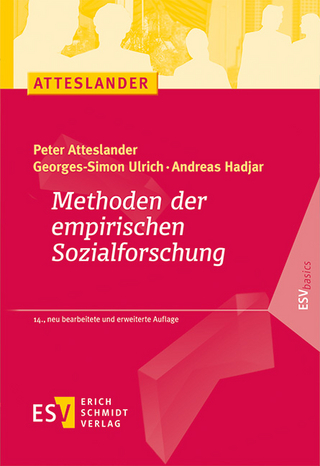
Introduction to Mediation, Moderation, and Conditional Process Analysis
Guilford Press (Verlag)
978-1-4625-3465-4 (ISBN)
*Bestselling reference and text, now updated: 50% new material includes six new chapters and the only documentation for PROCESS v3.
*Hayes is the developer of PROCESS, a free add-on for SPSS and SAS that takes the computational burden off the researcher.
*Includes tips and advice, and carefully explains each step in an analysis using current, compelling data examples; e.g., studies of media influence, workplace dynamics, and attitudes toward disaster victims.
*Helps readers understand the link between statistics and causality, as well as what the data is telling them.
*Hayes conducts workshops worldwide and gets raves for his blog and discussion board; his website offers free PROCESS downloads plus data files for the book's examples.
.
I. Fundamentals
1. Introduction
1.1. A Scientist in Training
1.2. Questions of Whether, If, How, and When
1.3. Conditional Process Analysis
1.4. Correlation, Causality, and Statistical Modeling
1.5. Statistical and Conceptual Diagrams, and Antecedent and Consequent Variables
1.6. Statistical Software
1.7. Overview of This Book
1.8. Chapter Summary
2. Fundamentals of Linear Regression Analysis
2.1. Correlation and Prediction
2.2. The Simple Linear Regression Model
2.3. Alternative Explanations for Association
2.4. Multiple Linear Regression
2.5. Measures of Model Fit
2.6. Statistical Inference
2.7. Multicategorical Antecedent Variables
2.8. Assumptions for Interpretation and Statistical Inference
2.9. Chapter Summary
II. Mediation Analysis
3. The Simple Mediation Model
3.1. The Simple Mediation Model
3.2. Estimation of the Direct, Indirect, and Total Effects of X
3.3. Example with Dichotomous X: The Influence of Presumed Media Influence
3.4. Statistical Inference
3.5. An Example with Continuous X: Economic Stress among Small-Business Owners
3.6. Chapter Summary
4. Causal Steps, Confounding, and Causal Order
4.1. What about Baron and Kenny?
4.2. Confounding and Causal Order
4.3. Effect Size
4.4. Statistical Power
4.5. Multiple Xs or Ys: Analyze Separately or Simultaneously?
4.6. Chapter Summary
5. More Than One Mediator
5.1. The Parallel Multiple Mediator Model
5.2. Example Using the Presumed Media Influence Study
5.3. Statistical Inference
5.4. The Serial Multiple Mediator Model
5.5. Models With Parallel and Serial Mediation Properties
5.6. Complementarity and Competition among Mediators
5.7. Chapter Summary
6. Mediation Analysis with a Multicategorical Antecedent X
6.1. Relative Total, Direct, and Indirect Effects
6.2. An Example: Sex Discrimination in the Workplace
6.3. Using a Different Group Coding System
6.4. Some Miscellaneous Issues
6.5. Chapter Summary
III. Moderation Analysis
7. Fundamentals of Moderation Analysis
7.1. Conditional and Unconditional Effects
7.2. An Example: Climate Change Disasters and Humanitarianism
7.3. Visualizing Moderation
7.4. Probing an Interaction
7.5. The Difference between Testing for Moderation and Probing It
7.6. Artificial Categorization and Subgroups Analysis
7.7. Chapter Summary
8. Extending the Fundamentals of Moderation Analysis
8.1. Moderation with a Dichotomous Moderator
8.2. Interaction between Two Quantitative Variables
8.3. Hierarchical versus Simultaneous Entry
8.4. The Equivalence between Moderated Regression Analysis and a 2 × 2 Factorial Analysis of Variance
8.5. Chapter Summary
9. Some Myths and Further Extensions of Moderation Analysis
9.1. Truths and Myths about Mean Centering
9.2. The Estimation and Interpretation of Standardized Regression Coefficients in a Moderation Analysis
9.3. A Caution on Manual Centering and Standardization
9.4. More than One Moderator
9.5. Comparing Conditional Effects
9.6. Chapter Summary
10. Multicategorical Focal Antecedents and Moderators
10.1. Moderation of the Effect of a Multicategorical Antecedent Variable
10.2. An Example from the Sex Discrimination in the Work Place Study
10.3. Visualizing the Model
10.4. Probing the Interaction
10.5. When the Moderator is Multicategorical
10.6. Using a Different Coding System
10.7. Chapter Summary
IV. Conditional Process Analysis
11. Fundamentals of Conditional Process Analysis
11.1. Examples of Conditional Process Models in the Literature
11.2. Conditional Direct and Indirect Effects
11.3. Example: Hiding Your Feelings from Your Work Team
11.4. Estimation of a Conditional Process Model using PROCESS
11.5. Quantifying and Visualizing (Conditional) Indirect and Direct Effects
11.6. Statistical Inference
11.7. Chapter Summary
12. Further Examples of Conditional Process Analysis
12.1. Revisiting the Disaster Framing Study
12.2. Moderation of the Direct and Indirect Effects in a Conditional Process Model
12.3. Statistical Inference
12.4. Mediated Moderation
12.5. Chapter Summary
13. Conditional Process Analysis with a Multicategorical Antecedent
13.1. Revisiting Sexual Discrimination in the Work Place
13.2. Looking at the Components of the Indirect Effect of X
13.3. Relative Conditional Indirect Effects
13.4. Testing and Probing Moderation of Mediation
13.5. Relative Conditional Direct Effects
13.6. Putting It All Together
13.7. Chapter Summary
V. Miscellanea
14. Miscellaneous Topics and Some Frequently Asked Questions
14.1. A Strategy for Approaching a Conditional Process Analysis
14.2. How Do I Write about This?
14.3. Should I Use Structural Equation Modeling Instead of Regression Analysis?
14.4. The Pitfalls of Subgroups Analysis
14.5. Can a Variable Simultaneously Mediate and Moderate Another Variable’s Effect?
14.6. Interaction between X and M in Mediation Analysis
14.7. Repeated Measures Designs
14.8. Dichotomous, Ordinal, Count, and Survival Outcomes
14.9. Chapter Summary
Appendices
Appendix A. Using PROCESS
Appendix B. Constructing and Customizing Models in PROCESS
Appendix C. Monte Carlo Confidence Intervals in SPSS and SAS
References
About the Author
| Erscheinungsdatum | 16.02.2018 |
|---|---|
| Reihe/Serie | Methodology in the Social Sciences |
| Verlagsort | New York |
| Sprache | englisch |
| Maße | 178 x 254 mm |
| Gewicht | 1340 g |
| Themenwelt | Geisteswissenschaften ► Psychologie |
| Medizin / Pharmazie | |
| Sozialwissenschaften ► Soziologie ► Empirische Sozialforschung | |
| ISBN-10 | 1-4625-3465-1 / 1462534651 |
| ISBN-13 | 978-1-4625-3465-4 / 9781462534654 |
| Zustand | Neuware |
| Informationen gemäß Produktsicherheitsverordnung (GPSR) | |
| Haben Sie eine Frage zum Produkt? |
aus dem Bereich



